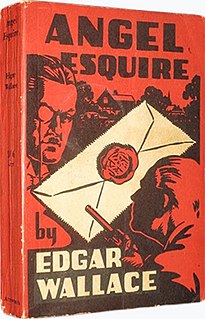
Angel Esquire is a 1908 crime mystery novel by the British writer Edgar Wallace. The wealthy owner of a gambling establishment leaves his money to whichever of his potential heirs can solve a complex puzzle. The title comes from the Scotland Yard detective Christopher Angel, who becomes involved with the case.

The Angel of Terror is a 1922 crime novel by the British writer Edgar Wallace.
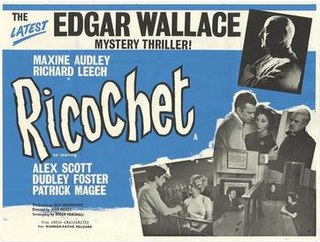
Ricochet is a 1963 British crime film directed by John Llewellyn Moxey and starring Maxine Audley, Richard Leech and Alex Scott. Part of the long-running series of Edgar Wallace Mysteries films made at Merton Park Studios, it is based on the 1922 novel The Angel of Terror.
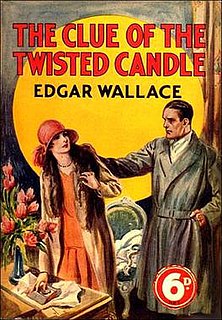
The Clue of the Twisted Candle is a 1918 crime novel by the British writer Edgar Wallace.

The Gunner is a 1928 crime novel by the British writer Edgar Wallace.
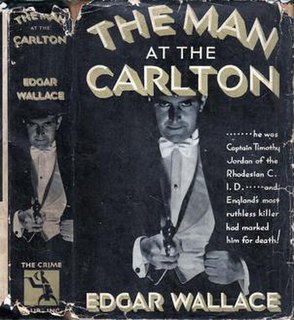
The Man at the Carlton is a 1931 crime novel by the British writer Edgar Wallace.

The Three Oak Mystery is a 1924 crime novel by the British writer Edgar Wallace.

Marriage of Convenience is a 1960 British crime film directed by Clive Donner and starring Harry H. Corbett, John Cairney and John Van Eyssen. Part of the long-running series of Edgar Wallace Mysteries films made at Merton Park Studios, it is based on the 1924 novel The Three Oak Mystery.

The Green Ribbon is a 1929 crime novel by the British writer Edgar Wallace. Like a number of Wallace's novels it is set against the backdrop of the horseracing world.

The Man Who Bought London is a 1915 crime novel by the British writer Edgar Wallace. It was originally published as a magazine serialisation.

Time to Remember is a 1962 British crime film directed by Charles Jarrott and starring Yvonne Monlaur, Harry H. Corbett and Robert Rietty.
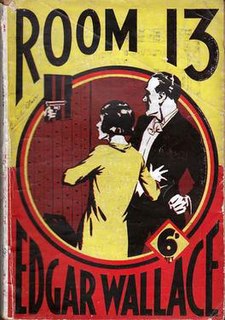
Room 13 is a 1924 crime novel by the British writer Edgar Wallace. It was the first in a series of books featuring the character of J. G. Reeder, a mild-mannered civil servant who is a brilliant detective.

The Melody of Death is a 1915 crime novel by the British writer Edgar Wallace. Believing that he is suffering from a fatal illness a newly-married man begins to commit a series of crimes to make sure his wife will be provided for after his death.

Man Detained is a 1961 British crime film directed by Robert Tronson and starring Bernard Archard, Elvi Hale and Paul Stassino. Part of the long-running series of Edgar Wallace Mysteries films made at Merton Park Studios, it is loosely based on the 1916 novel A Debt Discharged by Edgar Wallace.

The Man Who Knew is a 1918 British thriller novel by Edgar Wallace. A detective investigates the death of a South Africa diamond magnate in London.

Partners in Crime is a 1961 British crime film directed by Peter Duffell and starring Bernard Lee, Moira Redmond and John Van Eyssen. Part of the long-running series of Edgar Wallace Mysteries films made at Merton Park Studios, it is loosely based on the 1918 novel The Man Who Knew by Edgar Wallace.

The Salzburg Connection is a 1968 spy novel by the British-born writer Helen MacInnes. A British intelligence agent attempts to retrieve a box hidden in Austria containing the names of a list of Nazi collaborators left over from the war. Before long several other agencies are also after the prize.

Weekend at Thrackley is a 1934 detective novel by the British writer Alan Melville. A whodunit with comic overtones, it takes the form of a country house mystery, a genre at its height during the decade. His debut novel, it was a commercial success and led to him giving up his job in the timber trade to become a full-time writer. It was reissued in 2018 by the British Library Publishing as part of a group of crime novels from the Golden Age of Detective Fiction.
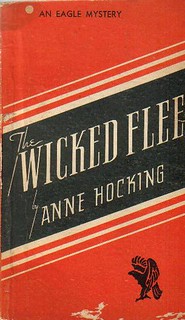
The Wicked Flee is a 1940 mystery crime novel by the British writer Anne Hocking. It was the second novel in a long-running series featuring her detective character Chief Inspector William Austen of Scotland Yard.
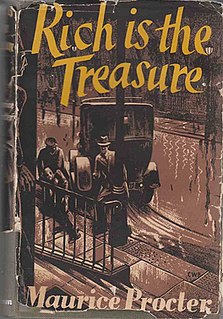
Rich Is the Treasure is a 1952 crime novel by the British writer Maurice Procter. It is the second in a trilogy featuring Scotland Yard Detective Superintendent Philip Hunter, which he wrote alongside the better known series featuring Chief Inspector Harry Martineau. The plot revolves around a gang creating counterfeit diamonds.




















